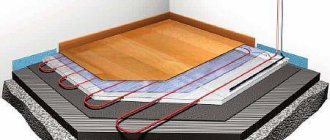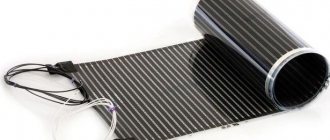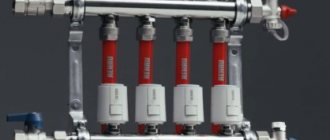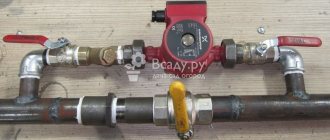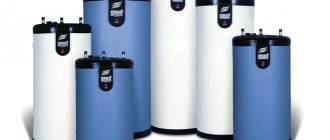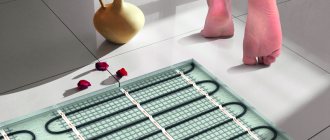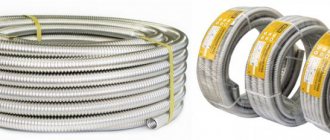Rod heated floor is one of the types of additional room heating systems. This is the latest development, which is gaining increasing popularity. Such systems are mats with carbon rods installed parallel to each other at a distance of 10 cm, depending on the model and manufacturer. An electric current passing through the rods heats them, with a maximum temperature reaching 60°C.
Laying rod heated floors
Thanks to this heating, an optimal microclimate in the room is ensured, and when the maximum temperature is reached, the carbon rods stop consuming electricity - they are self-regulating. Due to this, energy consumption is significantly saved, especially if a thermostat is included in the system.
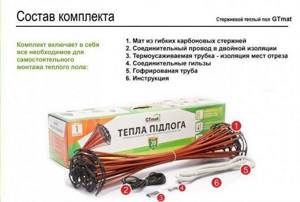
Composition of the rod heated floor kit
The energy released by such a heating system is called infrared - it is best perceived by the human body. When heat is generated by the core floor, the air in the room does not dry out, it is easy to breathe, and headaches do not occur.
Features of rod mats
An infrared heating system based on carbon rods has many advantages:
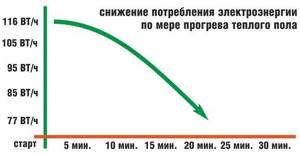
Reducing energy consumption with core heated floors
- Energy saving - with active use, at full power, up to 60% of electricity is saved compared to cable heated floors.
- Self-regulation - infrared mats stop consuming electricity when they reach the maximum temperature, so there is no need to be afraid of overheating or being blocked by furniture - the mats can be laid along the entire perimeter of the floor. And cable cables should absolutely not be placed in places where there will be sofas or cabinets.
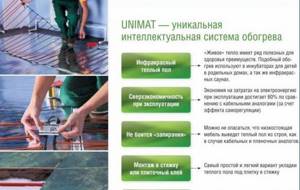
Important advantages of rod heated floors - Environmentally friendly - the floor will release energy and ions that are beneficial to humans, which also have a healing effect. If the system is laid under ceramic tiles, the effect is enhanced, since it acts as the best heat conductor.
- Reliability - since the rods are installed in parallel, even if one element fails, the operation of the others will not be disrupted.
- Versatility - the core coating can be used for any finishing finish:
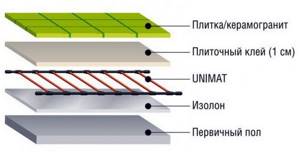
Unimat rod heated floor for tiles; - laminate;
- carpet;
- parquet.
Disadvantages include high cost and a small selection of manufacturers.
Caleo Unimat rod heated floor
[ads-mob-1][ads-pc-1]
Design of rod mats for heated floors
The mats are formed by connecting carbon rods with wires through which current will be supplied. The system includes:
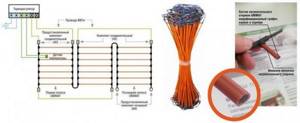
Installation of a rod infrared heated floor
- connecting elements;
- corrugated tube;
- connecting wires;
- end kit
The mats are sold in rolls; during installation, they are spread on the floor and fastened to each other with fasteners provided by the manufacturer. For additional fixation, you can use construction tape. A corrugated pipe is necessary to install an electronic floor sensor in it, which will record the heating temperature and transmit signals to the thermostat.
Structure and properties
This type of infrared floor heating heater has the form of many rods that are connected in parallel using flexible connecting wires. They are somewhat reminiscent of a rope ladder. The rods contain a material consisting of carbon, silver and copper. When carbon is exposed to current, it intensely releases thermal energy. What is good about a rod carbon floor is that it has self-regulating properties: the amount of heat generated depends on its temperature. That is, with a local increase in temperature (you put something on the floor, the floor became hot due to poor heat transfer), it emits less heat and the temperature drops. This property does not mean that a system with rod heaters does not need a thermostat. The thermostat controls power consumption (saves money on heating), and self-regulation prevents overheating (extends the “life”).
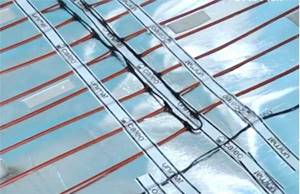
Rod infrared self-regulating mat
A heating rod heating system, like all electric underfloor heating systems, requires the installation of a thermostat and a floor temperature sensor. Without them, the heating elements work, but constantly at the same power. In this case, we are not talking about any savings, and the service life becomes much shorter.
What should not be included in a set of infrared mats
Today you can find many fake rod-based heated floors that do not meet safety requirements and can lead to short circuits, fire and other negative consequences.
Such fakes can be easily identified by the composition of the kit:
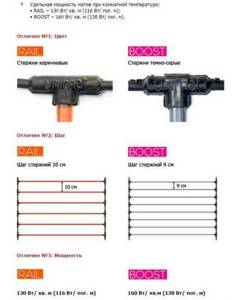
Characteristics of rod heated floors
- the width of the mat is usually only 80 cm, but should be 83;
- Self-tapping screws were used to connect the rods (and in the original models, copper staples). Self-tapping screws quickly oxidize and damage the rods;
- unpleasant odor during inspection. Before pouring the screed, any rod-based heated floor must be checked for serviceability by turning it on at full power for several hours. During operation, fake mats will have an unpleasant odor, similar to burnt plastic;
- lack of brand markings, instructions and a disk with installation instructions.
Reviews
Since all the manufacturers mentioned above indicate the word Unimat in parentheses, it is almost impossible to figure out who bought what. Now about the reviews themselves. Almost everyone is unhappy. Moreover, the picture is approximately the same: the first year/heating season everything is fine, but in the second year problems begin. Moreover, the nature of the damage is the same for all: the junctions of the rods and the supply conductor burn out. Apparently, this is the weak point of such systems. But there are reviews, according to which, people have used such floors for years without incident.
Main technical characteristics of the most common models of infrared mats
Heating systems with carbon rods are just entering the market in our country, and there are not many manufacturers, or rather, only two:
- FENIX;
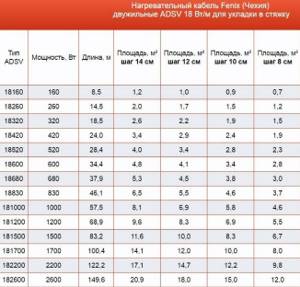
FENIX heating cable table - CALEO.
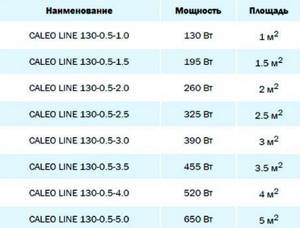
Technical characteristics of Caleo core heated floors
The characteristics of the products are almost the same, the differences being the width between the rods, the length of the mats and their power.
Comparative characteristics of some models of infrared floors:
| Name | Step between rods, cm | Mat width, m | Mat length, m | Power, W/m2 | Price, rub./m |
| UNIMAT RAIL | 10 | 0,83 | 25 | 130 | 2902 |
| UNIMAT BOOST | 9 | 0,83 | 25 | 160 | 2638 |
| FENIX RHE | 10 | 0,83 | 20 | 116 | 1900 |
Results
The idea of infrared floor heating seems very attractive: probably everyone wants not only to warm up, but also to be treated and relax at the same time. Moreover, they promise that rod heating mats will consume little electricity: they only work for 6-8 hours, the rest of the time they are turned off. But after reading the reviews, you wonder if it’s worth it. Maybe infrared film would be better? The reviews there are normal. Or even cable heating? It's much cheaper...
Technology for installing rod mats under tiles
Most often, a rod-based heated floor is chosen for installation under tiles, since this is the easiest way to equip an additional heating system. Ceramic tiles are a good conductor of heat, so this finish will provide the best heating.
Installation of heated floors under tiles
Installation under ceramic tiles is quite simple, but if you plan to install a thermostat, it is better to use the services of a professional electrician, since this work involves a risk to life.
First you need to do the preparatory work:
- clean the base from debris and unnecessary objects;
- if necessary, polyethylene film is spread for waterproofing;
- To enhance the reflection of thermal energy, a layer of foil insulation is required.
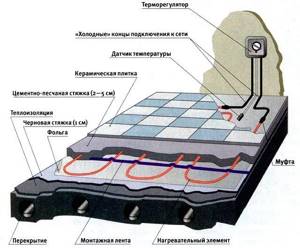
Installation diagram of a rod heated floor under tiles
Next comes the stage of installing heat sensors and laying out the rod mats:

Correct layout of the rod-heated floor
- before purchasing, you need to accurately calculate the total floor area and, accordingly, the number of mats;
- carbon rods fastened with wire are laid out on the thermal insulation layer;
- to fasten the mats, the original fasteners that are included in the kit and adhesive tape are used;
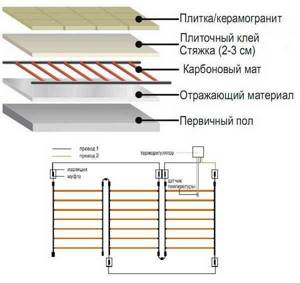
Laying and connecting the rod mat - the next stage is the installation of a thermostat and floor temperature sensors;
- connecting the mat wires to the thermostat terminals;
- connecting the floor temperature sensor to the thermostat;
- checking the functionality of the system - at this stage, the infrared floor is connected to the power supply and left for several hours, possibly for a day;
- If the check does not reveal any malfunctions, you can start pouring the screed or gluing ceramic tiles.
If thermomats are used under tiles, you can immediately apply glue on top of them, in a layer of at least 1 cm.
[ads-pc-2][ads-mob-2]
Design features of carbon rods
A material based on polyester and polyethylene is used as a protective insulating shell for carbon rods.
Inside, the heating elements are filled with a carbon-polymer composite material. To connect them, a heat-resistant stranded copper wire 2.5 mm thick is used, which is additionally protected by a 3 mm sheath.
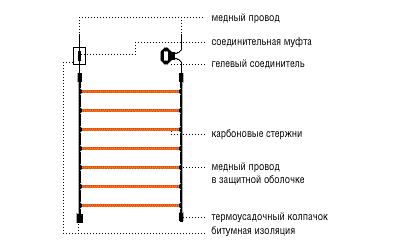
Those who have tried the innovative heating system from personal experience claim that there is currently no alternative to it. A room with such heating is always dry and warm, while the natural humidity of the air is not disturbed. Such conditions are provided by a technically unique intelligent system, implemented on completely new principles for the design of heating elements. Carbon heated floors are also an economical way to heat a room, which is extremely important especially recently.

